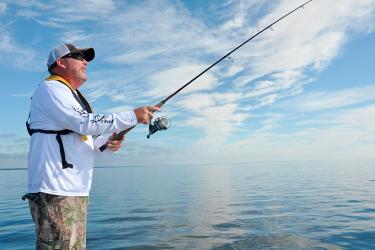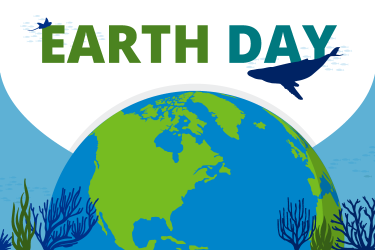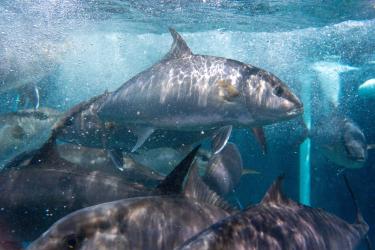The ocean and its inhabitants continue to capture our attention. Take a look at NOAA Fisheries top stories, podcasts, and videos of 2024. Scroll down to see which topics were most popular.
Top Features
Whales, snow crabs, and salmon habitat made a big splash in our 2024 feature stories.
1. A Boater Drove Through a Pod of Killer Whales. Turns Out a Wildlife Videographer Was Filming.
The number one story of the year involves a Bellingham, Washington, man who agreed to pay a $1,000 civil penalty after a nearby wildlife videographer recorded his 51-foot recreational vessel passing through a pod of killer whales on the west side of San Juan Island in 2022.
2. New Research Reveals Full Diversity of Killer Whales as Two Species Come into View on Pacific Coast
Our second most popular story of the year also belongs to whales. Scientists have resolved one of the outstanding questions about one of the world’s most recognizable creatures, identifying two well-known killer whales in the North Pacific Ocean as separate species. Long viewed as one worldwide species, killer whale diversity now merits more.
3. Snow Crab Collapse Due to Ecological Shift in the Bering Sea
Our third most read story highlights ecological shifts that caused the snow crab collapse in the Bering Sea. NOAA Fisheries scientists attribute the abrupt collapse of snow crab in Alaska to borealization, or an ecological shift from Arctic to sub-Arctic conditions in the southeastern Bering Sea due to human-caused climate change.
4. World’s Biggest Dam Removal Project to Open 420 Miles of Salmon Habitat this Fall
Fourth on the list was epic habitat restoration! The dam removal on the lower Klamath River, allowing salmon to reenter 420 miles of habitat for the first time in a century, takes this spot. NOAA recommended $20 million in funding for additional river restoration.
5. Whales and Carbon Sequestration: Can Whales Store Carbon?
And finally, whales and carbon sequestration made the top five stories of 2024. Did you know that whales can help mitigate climate change impacts by storing carbon in their bodies and transporting nutrients that benefit ocean food chains? It's true!
Top Podcasts
Listen up! Check out the five most downloaded podcasts of the year. Our "pods" covered a wide range of hot topics including Alaska snow crab populations, North Atlantic right whale conservation, monkfish, the elusive North Pacific right whale, and even how AI help identify mysterious whale calls.
1. What Happened to All the Alaska Snow Crab?
A few years ago, snow crab populations in Alaska collapsed. Hear how NOAA biologists solved the mystery of what happened to them.
2. A Game-Changing Effort for North Atlantic Right Whales
An update from our experts on the status of North Atlantic right whales, and our plans to use Inflation Reduction Act funds for right whale conservation
3. Why You Should Try Monkfish
Eat more monkfish! A nonprofit agency in New York works to increase demand and consumption of monkfish in the Northeast.
Listen here
4. Documenting the Elusive North Pacific Right Whale
North Atlantic right whales get a lot of attention. In this episode, we learn a little about their lesser known West Coast cousins: North Pacific right whales, whose numbers are dramatically low.
5. AI Identified Mysterious Whale Calls
Hear from the NOAA Fisheries scientist who identified Bryde’s whales as the source of a new whale call—biotwang—in the North Pacific. With Google AI and machine learning, we sorted through thousands of hours of acoustic recordings to identify these calls.
Listen here
Top Social Media Posts
Our top post on Instagram in 2024 features a very weird pair: Hawaiian monk seals and ... eels. We're not exactly sure why—or how—these eels get in their noses. Monk seals do eat eels, so maybe the eel was trying to escape? Our scientists also guessed that maybe the seal could have swallowed the eel and regurgitated it so that the eel came out the wrong way. Yuck!
Hawaiian monk seals often find themselves in difficult situations, and our staff works hard to prevent and reduce threats to this highly endangered species.
Check out ten ways NOAA helps Hawaiian monk seals
Our top Facebook post of 2024 showcased the recovery of Pacific bluefin tuna. The species achieved a major milestone, exceeding international targets a decade ahead of schedule. The rebuilding of Pacific bluefin tuna reflects a fisheries management success. International organizations cooperated across the Pacific to reverse decades of overfishing for the prized species.
From Overfished to Sustainable Harvests: Pacific Bluefin Tuna Rebound to New Highs
X
The most popular post on X this year highlights baby coral! The post gave a look at how NOAA Fisheries grow swiftia exserta corals in our Galveston lab. Once they’re big enough, we’ll plant them in the Gulf of America (formerly Gulf of Mexico) as part of a project to restore coral reefs that were harmed by the Deepwater Horizon oil spill.
Watch a short clip of hungry baby coral
Top Videos
Whale whale whale ... what do we have here? Our top five most viewed videos across NOAA Fisheries social media accounts for 2024 all included—you guessed it—whales!
- North Atlantic right whale found in Ireland
- Whale falls in the San Pedro Basin
Using drones and tags to study Rice's whales
See how NOAA Fisheries and partners get an up-close look at the life of these endangered whales
- Killer whale stranded on beach in Carmel, California
Thanks for Reading and Viewing
Thank you for joining us throughout this year. We are excited to keep sharing important news and science on marine life and ocean resources in 2025—stay tuned!
















